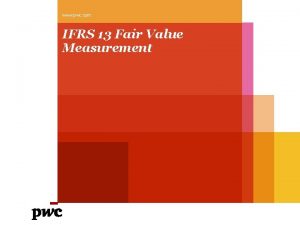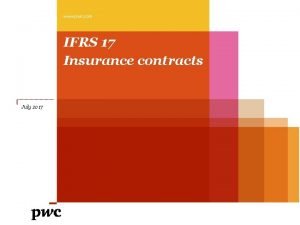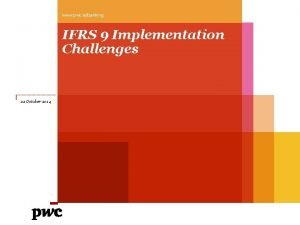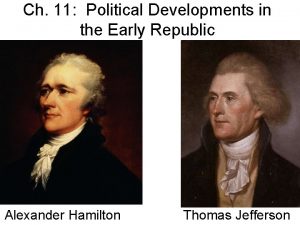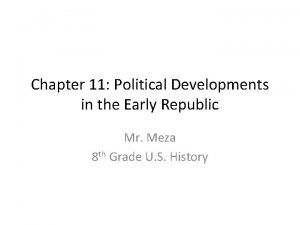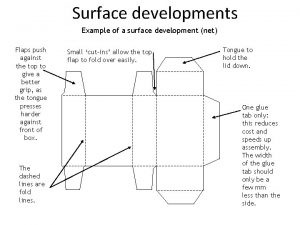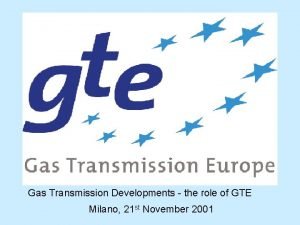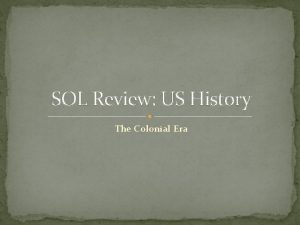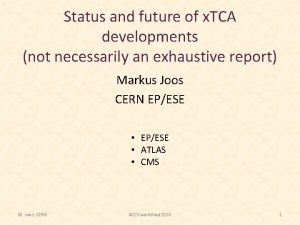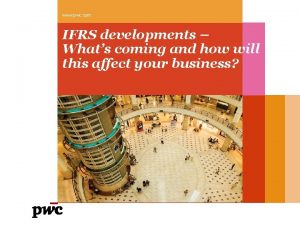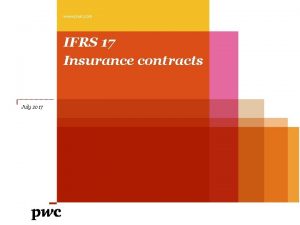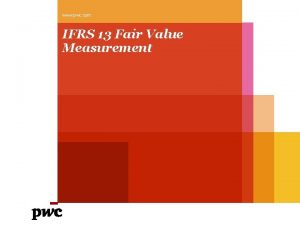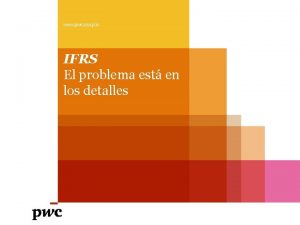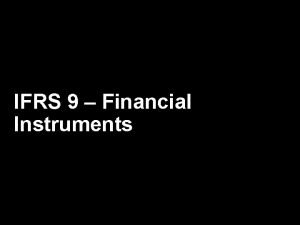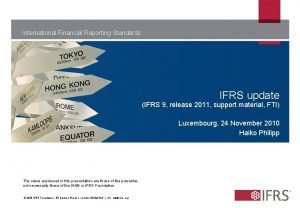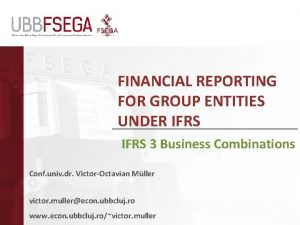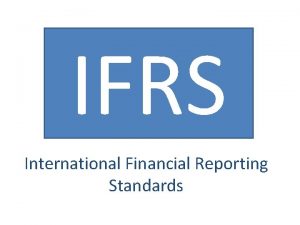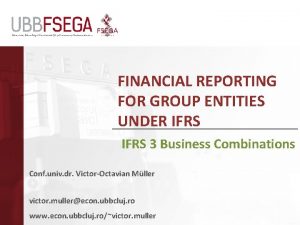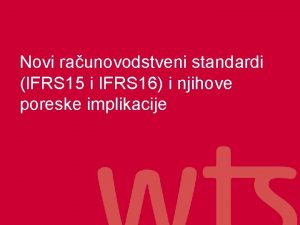www pwc com IFRS developments Whats coming and



















- Slides: 19

www. pwc. com IFRS developments – What’s coming and how will this affect your business?

IASB’s work plan Financial Instruments – Macro hedging General Presentation and Disclosures Rate-regulated Activities Conceptual Framework Disclosure Initiative Others Pw. C 2

New accounting developments IFRS 17 Insurance contracts (issued) Pw. C New Requirements Impact • Final standard issued on 18 May 2017, which will come into effect on 1 January 2023 (see next slide for detail of recent amendment) • Scope: all insurance contracts issued by any entity and investment contracts with discretionary participating features issued by insurers • Current measurement model: estimates re-measured each reporting period • Use of OCI optional for difference between discounted cash flows using current market rates and the discount rates on an appropriate cost basis • Changes in cash flow and risk adjustment related to future coverage and other services to be recognised against contractual service margin (CSM) • A variable fee approach (VFA) will be used for direct participating contracts whereas indirect participating contracts will apply the building block approach (BBA) for non-participating contracts. A simplified premium allocation approach (PAA) is available for non-complex contracts, such as contracts with coverage periods of no more than 12 months. • Presentation of insurance contract revenue and expenses aligns with other industries, and premium information is prohibited in the p/l • Transition: full retrospective application for insurance contracts in force at transition unless it is impractical, in which case may use the simplified retrospective approach or the fair value approach. • IASB published the amendments to IFRS 4 in September 2016 that introduces the overlay and deferral approaches to address concerns over different effective dates for IFRS 9 and IFRS 17, and the disclosure requirements under different approaches. • Reduces income statement volatility to some extent • Adds significant complexity and creates extra demands on resources, data and modelling systems 3

New accounting developments Amendment to IFRS 17 Insurance contracts (issued) Pw. C Amendment Impact • In June 2020, the IASB issued an amendment to IFRS 17, together with an amendment to IFRS 4, so that eligible insurers can still apply IFRS 9 alongside IFRS 17. Details include: • Effective date: deferred to 1 January 2023 • Expected recovery of insurance acquisition cash flows: entity is required to allocate part of the acquisition costs to related expected contract renewals, recognise an asset and assess its recoverability at b/s date as well as disclose specific information in the notes. • CSM attributable to investment services: Coverage units should be identified for both insurance coverage and investment services, for contracts under the VFA and for other contracts with an ‘investment-return service’ under the general model. • Reinsurance contract held (RCH) - recovery of losses: When an onerous group of underlying insurance contracts is recognised, a gain on the related RCH is recognised by adjusting its CSM, which is determined by multiplying the loss recognised on the underlying contracts and the percentage of claims expected to be recovered from the RCH. • Other amendments to IFRS 17 include: • Scope exclusions for some credit card (or similar) contracts, and some loan contracts. • B/S presentation of insurance contract assets and liabilities in portfolios instead of groups. • Applicability of the risk mitigation option when mitigating financial risks using RCH and non-derivative financial instruments at FVTPL. • An accounting policy choice to change the estimates made in previous interim financial statements. • Inclusion of income tax that are specifically chargeable to the policyholder. • Selected transition reliefs and other minor amendments. • Affect all jurisdictions that apply IFRS 17 • Affect entities outside the insurance industry that issue insurance contacts, including loans with embedded insurance and certain credit card contracts 4

New accounting developments DP: Macro hedging – Accounting for Dynamic Risk Management Pw. C Proposed Requirements Impact • Use of a ‘portfolio revaluation approach’ rather than a full fair value approach. The new approach involves identifying risks being managed in an open portfolio and revaluing their exposure using a present value technique • Does not require one-to-one matching of hedged item and hedging instrument • Introduces conceptual challenge of inclusion of behavioural features, rather than just contractual features • Revaluation adjustments and FV changes of hedging instruments are accounted for in P/L. Alternative presentations are suggested for the revaluation adjustments in the statement of financial position and the statement of comprehensive income • At its May 2015 meeting, the IASB tentatively decided: • that it should first consider how the information needs of constituents concerning dynamic risk management activities could be addressed through disclosures before considering those areas that need to be addressed through recognition and measurement; • to prioritise the consideration of interest rate risk and consider other risks at a later stage in the project; and • to establish an Expert Advisory Panel at a later stage in the project • At its November 2017 meeting, the IASB tentatively agreed that cash flow hedge mechanics better reflects dynamic risk management in financial reporting and continues to work on a core model based on these mechanics. At its February 2018 meeting, the IASB discussed the application of qualifying criteria to the asset profile, as well as designation of items within the asset profile and documentation requirements. At its recent meetings, the IASB discussed the role of the target profile within the dynamic risk management model, the application of qualifying criteria to the target profile, designation of items within the target profile and the documentation requirements, designation and de-designation of derivatives, imperfect alignment, how the minimum performance requirements would be applied in the context of the DRM accounting model, whether the DRM model should preclude an entity from designating specific types of strategies within the target profile, as well as how derivatives designated within the DRM model should be presented in financial statements. • The Board is exploring whether it can develop an accounting model that will enable investors to understand a company’s dynamic risk management activities and to evaluate the effectiveness of those activities. To assist stakeholders affected by the coronavirus pandemic, the outreach on the core model will be postponed to H 2 2020. • Replaces the current fair value hedge accounting of interest rate risk 5

New accounting developments ED: General Presentation and Disclosures Proposed Requirements Impact The Board proposed new requirements for presentation and disclosure in financial statements, with a focus on the statement of profit or loss, in response to concerns from investors about the comparability and transparency of companies’ performance reporting. Exposure draft was published in December 2019. Comment period ended 30 September 2020. The Board discussed feedback on the Exposure Draft in December 2020. At the next meeting, the Board will continue discussing feedback on the Exposure Draft and will discuss plans for redeliberating the project proposals. • The proposals are expected to affect all companies applying IFRS Standards In the Exposure Draft the Board proposes: • requiring additional subtotals in the statement of profit or loss. These subtotals would provide relevant information and create a more consistent structure to the statement of profit or loss, thereby improving comparability among companies. • requiring disaggregation to help a company to provide relevant information. The Board proposes disaggregation principles, disaggregation of operating expenses either by nature or by function in the statement of profit or loss, a requirement for disaggregation of large ‘other' balances, a requirement to disaggregate information about unusual income and expenses and additional minimum line items in the statement of financial position. • requiring disclosure of some management-defined performance measures—that is, performance measures not specified by IFRS Standards. To promote transparency, the Board proposes reconciliations between some management-defined performance measures and subtotals specified by IFRS Standards. • limited changes to the statement of cash flows to improve consistency in classification by removing options. Pw. C 6

New accounting developments Rate-regulated activities Pw. C Proposed Requirements Impact • IASB is developing a new accounting model to give users of financial statements better information about a company's incremental rights and obligations arising from its rate-regulated activities. The staff is preparing an exposure draft for balloting. IASB expects to publish its proposals in an exposure draft in January 2021. • At the IASB’s meetings in May, June and July 2017, the Board has discussed whether rights and obligations created by the rate adjustment mechanism are assets and liabilities and the role that different types of uncertainty plays in the recognition of such rights and obligations • At its meetings in 2018, IASB discussed the possible accounting model being developed for activities subject to ‘defined rate regulation’. The IASB tentatively decided that the accounting model should apply to ‘defined rate regulation’ established through a formal regulatory framework that is binding on both the entity and regulator and establishes a basis for setting the rate for specified goods or services that includes a rate-adjustment mechanism. The IASB has also tentatively decided that the measurement of regulatory assets should reflect estimates of future cash flows generated by those assets, which should be discounted if there is a significant financing component. Future cash flows should be estimated using either the ‘most likely amount’ method or the ‘expected value’ method and the same method should be applied consistently from the origination of the timing difference until its reversal. The Board also discussed how an entity should determine whether to consider the outcome of each timing difference separately or together with one or more other timing differences. • Presentation, disclosure and the interactions between the model and IFRS standards were discussed in the November 2018 IASB meeting. • In its December 2018 meeting, the IASB discussed discount rate to be used when measuring regulatory assets or regulatory liabilities arising from regulatory timing differences, that relate to items forming part of the regulatory capital base, that relate to items forming part of the regulatory operating expenditure and that relate to items of expense or income that will form part of the regulatory operating expenditure or the regulatory capital base when cash is paid or received. The Board expects to continue deliberations on these issues at a future meeting. • The IASB met in May and June 2019 for educational sessions and discussed the general principles, including scope and definitions of regulatory assets and regulatory liabilities, measurement, presentation and disclosure issues. • In its July 2019 meeting, the IASB tentatively decided that, as an exception to the recognition and measurement principles of IFRS 3, an entity should recognise and measure regulatory assets acquired and regulatory liabilities assumed in a business combination in accordance with the recognition and measurement principles of the model. • Common in utilities industry, but might affect other industries where prices are regulated, eg. certain health insurance products 7

New accounting developments Amendments Impact Amendments to IAS 1 on Classification of liabilities as current or non -current • Clarify that liabilities are classified as either current or non-current, depending on the rights that exist at the end of the reporting period. The amendment requires the following: • Liabilities are classified as non-current if the entity has a substantive right to defer settlement for at least 12 months at the end of the reporting period. • The assessment determines whether a right exists, but it does not consider whether the entity will exercise the right. • The right to defer only exists if the entity complies with any relevant conditions at the reporting date. • ‘Settlement’ is defined as the extinguishment of a liability with cash, other economic resources or an entity’s own equity instruments. There is an exception for convertible instruments that might be converted into equity, but only for those instruments where the conversion option is classified as an equity instrument as a separate component of a compound financial instrument. • Effective 2022 but can be early adopted. IASB proposed to defer the effective date by one year to provide companies with more time to implement any classification changes resulting from the amendments. • Reconsider the current or noncurrent classification of a liability at the end of the reporting period Amendment to IFRS 3 on Reference to the Conceptual Framework • Updated IFRS 3 to refer to the 2018 Conceptual Framework for Financial Reporting • Added a new exception to specify that, for some types of liabilities and contingent liabilities, an entity applying IFRS 3 should instead refer to IAS 37 or IFRIC 21, rather than the 2018 Conceptual Framework. • Applies to business combinations for which the acquisition date is on or after the beginning of the first annual reporting period beginning on or after 1 January 2022. • Limited Pw. C 8

New accounting developments Amendments Impact Amendment to IAS 37 on Cost of Fulfilling a Contract • Explains that the direct cost of fulfilling a contract comprises: • the incremental costs of fulfilling that contract (for example, direct labour and materials); and • an allocation of other costs that relate directly to fulfilling contracts (for example, an allocation of the depreciation charge for an item of PP&E used to fulfil the contract). • Clarifies that, before a separate provision for an onerous contract is established, an entity recognises any impairment loss that has occurred on assets used in fulfilling the contract, rather than on assets dedicated to that contract. • Effective 2022 but can be early adopted. Entity should apply those amendments to contracts for which it has not yet fulfilled all of its obligations at the beginning of the annual reporting period in which it first applies the amendments (the date of initial application). Comparative information should not be restated. • could particularly affect construction, manufacturing and service companies Amendment to IAS 16 on Proceeds before Intended Use • Prohibits an entity from deducting from the cost of an item of PP&E any proceeds received from selling items produced while the entity is preparing the asset for its intended use • Clarifies that an entity is ‘testing whether the asset is functioning properly’ when it assesses the technical and physical performance of the asset • Requires entities to separately disclose the amounts of proceeds and costs relating to items produced that are not an output of the entity’s ordinary activities • Effective 2022 but can be early adopted. Applied retrospectively, but only to items of PP&E that are brought to the location and condition necessary for them to be capable of operating in the manner intended by management on or after the beginning of the earliest period presented in the financial statements in which the entity first applies the amendments. • Limited Pw. C 9

New accounting developments Amendment to IFRS 16 on Covid-19 Related Rent Concessions Pw. C Amendments Impact • Provided lessees (but not lessors) with relief in the form of an optional exemption from assessing whether a rent concession related to COVID-19 is a lease modification. Lessees can elect to account for rent concessions in the same way as they would if they were not lease modifications. • The practical expedient only applies to rent concessions occurring as a direct consequence of the COVID-19 pandemic and only if all of the following conditions are met: • the change in lease payments results in revised consideration for the lease that is substantially the same as, or less than, the consideration for the lease immediately preceding the change; • any reduction in lease payments affects only payments due on or before 30 June 2021; and • there is no substantive change to other terms and conditions of the lease. • Mandatory for annual reporting periods beginning on or after 1 June 2020. Earlier application is permitted, including in interim or year end financial statements not yet authorised for issue at 28 May 2020, to permit application of the relief as soon as possible, subject to any endorsement process. • Given the pervasiveness of the pandemic and the measures taken by many governments on social distancing, it is likely that many lessees will have been granted a rent concession of some form and will be affected. 10

New accounting developments Amendments to IFRS 9, IAS 39, IFRS 7, IFRS 4 and IFRS 16 on Interest Rate Benchmark Reform — Phase 2 Proposed Requirements Impact The Board published Phase 2 amendments to IFRS 9, IAS 39, IFRS 7, IFRS 4 and IFRS 16 – interest rate benchmark (IBOR) reform on 27 August 2020, addressing issues that arise from the implementation of the reforms, including the replacement of one benchmark with an alternative one. In detail: The reliefs may affect companies in all industries, which has the IBOR related financial instruments, hedge accounting and leasing. • Accounting for changes in the basis for determining contractual cash flows as a result of IBOR reform: the amendments require entities, as a practical expedient, to account for such change by updating the effective interest rate using the guidance in paragraph B 5. 4. 5 of IFRS 9. As a result, no immediate gain or loss is recognised. • End date for Phase 1 relief for non contractually specified risk components in hedging relationships: The Phase 2 amendments require an entity to prospectively cease to apply the Phase 1 reliefs to a non contractually specified risk component at the earlier of when changes are made to the non contractually specified risk component, or when the hedging relationship is discontinued. • Additional temporary exceptions from applying specific hedge accounting requirements: • Changes to designations and hedge documentation: Amending the hedge documentation does not result in discontinuation • Amounts accumulated in the cash flow hedge reserve: Based on the alternative benchmark rate on which the hedged future cash flows are determined • IAS 39 retrospective effectiveness test: Option to reset to zero the cumulative fair value changes of the hedged item and hedging instrument • Groups of items: Hedged items are allocated to sub-groups based on the benchmark rate being hedged • Risk components: Reasonably expects the alternative benchmark rate will be separately identifiable within 24 months • Additional IFRS 7 disclosures related to IBOR reform: The amendments require disclosure of: (i) how the entity is managing the transition to alternative benchmark rates, its progress and the risks arising from the transition; (ii) quantitative information about derivatives and non-derivatives that have yet to transition, disaggregated by significant interest rate benchmark; and (iii) a description of any changes to the risk management strategy as a result of IBOR reform The amendments are effective from 1 January 2021, but early application is permitted. Pw. C 11

New accounting developments IASB annual improvements 2018 -2020 cycle (Effective from 1/1/2022 with earlier application permitted) Amendment Impact Amendment to IFRS 1 • Permit a subsidiary that elects to apply paragraph D 16(a) of IFRS 1 to measure —using the amount reported by the parent—cumulative translation differences for all foreign operations. This measurement is based on the parent’s date of transition to IFRSs. • The amendment would also apply to associates and joint ventures that elect to apply paragraph D 16(a) of IFRS 1. • Limited Amendment to IFRS 9 • Clarify the fees costs or fees paid to third parties should not be included in the 10% test for derecognition of financial liabilities • Applies to financial liabilities that are modified or exchanged on or after the beginning of the annual reporting period in which the entity first applies the amendment. • Limited Amendment to IFRS 16 • Remove the potential confusion regarding lease incentives by amending an Illustrative Example 13 accompanying IFRS 16. • Limited Amendment to IAS 41 • Remove the requirement for entities to exclude cash flows for taxation when measuring fair value under IAS 41 to align the fair value measurement requirements with those in other IFRS Standards. • Applies to fair value measurements on or after the beginning of the first annual reporting period beginning on or after 1 January 2022. • Limited Pw. C 12

New accounting developments Amendments Impact Amendments to IAS 1 and IAS 8 on Definition of material • Use a consistent definition of materiality throughout IFRSs and the Conceptual Framework for Financial Reporting • Clarify the explanation of the definition of material • Incorporate some of the guidance in IAS 1 about immaterial information • Effective 2020 but can be early adopted • Limited Amendment to IFRS 3 on Definition of a business • Clarify that to be considered a business, an acquisition would have to include an input and a substantive process that together significantly contribute to the ability to create outputs • Provides a framework to evaluate when an input and a substantive process are present (including for early stage companies that have not generated outputs) • Clarify that an entity can apply a ‘concentration test’ that, if met, eliminates the need for further assessment. Under this optional test, where substantially all of the fair value of gross assets acquired is concentrated in a single asset (or a group of similar assets), the assets acquired would not represent a business • Require prospective application to business combinations for which the acquisition date is on or after 1 January 2020 and to asset acquisitions that occur on or after the beginning of that period. Early application is permitted. • Likely result in more acquisitions being classified as acquisitions of assets • Affect all industries, most significantly real estate, pharmaceutical, and oil and gas Note: slide 13 to 14 are only applicable for entities with annual periods beginning after 1 January 2020 but before 1 January 2021. Pw. C 13

New accounting developments Amendments to IFRS 9, IAS 39 and IFRS 7 on IBOR Reform and its Effects on Financial Reporting— Phase 1 IASB issued amendments to IFRS 9, IAS 39 and IFRS 7 in relation to Interest Rate Benchmark Reform in September 2019. It provides certain reliefs which relate to hedge accounting and have the effect that IBOR reform should not generally cause hedge accounting to terminate. However, any hedge ineffectiveness should continue to be recorded in the income statement. In detail: • the hedged cash flows may change as a result of IBOR reform but this will not cause the ‘highly probable’ test to be failed. • an entity assumes that the interest rate benchmark on which the cash flows of the hedged item, hedging instrument or hedged risk are based is not altered by IBOR reform for prospective assessments. • a hedge is not discontinued during the period of IBOR-related uncertainty solely because the retrospective effectiveness falls outside this required 80– 125% range under IAS 39. • a non-contractually specified IBOR risk component only needs to be separately identifiable at initial hedge designation and not on an ongoing basis. In the context of a macro hedge, where an entity frequently resets a hedging relationship, the relief applies from when a hedged item was initially designated within that hedging relationship. • the amendment requires disclosure of the nominal amount of hedging instruments to which the reliefs are applied, any significant assumptions or judgements made in applying the reliefs, and qualitative disclosures about how the entity is impacted by IBOR reform and is managing the transition process. Impact The reliefs may affect companies in all industries which apply hedge accounting This amendment is effective from 1 January 2020 but early adoption is permitted. Subject to EU endorsement. Note: slide 13 to 14 are only applicable for entities with annual periods beginning after 1 January 2020 but before 1 January 2021. Pw. C 14

New accounting developments Proposed Requirements Impact ED: amendment to IFRIC 14 • Address how the powers of other parties, such as the Trustees of the plan, affect an entity’s right to a refund of a surplus from the plan • The Board decided not to finalise the proposed amendments to IFRIC 14. The Board will consider the project’s direction at a future meeting. More specifically, the Board will consider whether to develop new proposals to address the matter. • May impact entities that have defined benefit plans ED: amendment to IAS 8 • Clarify how accounting policies and accounting estimates relate to each other, by explaining that accounting estimates are used in applying accounting policies and making the definition of accounting policies clearer and more concise • Clarify that selecting an estimation technique, or valuation technique, used when an item in the financial statements cannot be measured with precision, constitutes making an accounting estimate • Clarify that, in applying IAS 2 Inventories, selecting the first-in, first-out (FIFO) cost formula or the weighted average cost formula for interchangeable inventories constitutes selecting an accounting policy • At its meeting in July 2020, the Board tentatively decided to change the effective date of the amendments to IAS 8 to annual reporting periods beginning on or after 1 January 2023 and permit early application. The Board expects to publish the amendments in Q 1 2021. • Limited Pw. C 15

New accounting developments Proposed Requirements Impact ED: amendment to IAS 12 • The proposed amendments would require an entity to recognise deferred tax on initial recognition of particular transactions to the extent that the transaction gives rise to equal amounts of deferred tax assets and liabilities. The proposed amendments would apply to particular transactions for which an entity recognises both an asset and a liability, such as leases and decommissioning obligations. • The Board tentatively decided that entities should apply the amendments for annual periods beginning on or after 1 January 2023, with earlier application permitted. • Amendment is expected in Q 2 2021. • Limited ED: amendment to IAS 1 and IFRS Practice Statement 2 • Replace the requirement in IAS 1 for entities to disclose their ‘significant’ accounting policies with a requirement to disclose ‘material’ accounting policies. • Amend IAS 1 and IFRS Practice Statement 2 to help entities apply the concept of materiality in making decisions about accounting policy disclosures. • The proposed amendments are intended to help entities provide accounting policy disclosures that are more useful to primary users of financial statements. • At its meeting in July 2020, the Board tentatively decided the effective date of the amendments to IAS 1 to annual reporting periods beginning on or after 1 January 2023 and permit early application. • At its meeting in December 2020, the Board tentatively decided not to add transition requirements and an effective date to the amendments to IFRS Practice Statement 2. The Board also tentatively decided that paragraph 117 B of IAS 1 should state that accounting policy information is expected to meet the definition of material if the accounting policy information is needed to understand other material information in the financial statements. • The Board expects to publish the amendments in Q 1 2021. • Limited Pw. C 16

New accounting developments ED: amendment to IFRS 16 Pw. C Proposed Requirements Impact • The proposed amendment specifies the method a seller-lessee uses in initially measuring the right-of-use asset and lease liability arising in a sale and leaseback transaction and how the seller-lessee subsequently measures that liability. • Comment period ends on 29 March 2021. • Limited 17

Actions to take now • • Pw. C Raise awareness of the changes with ― executives, directors and audit committee members; and ― operating divisions Assess the main impacts: ― acquisitions/disposals methods and contracts, ― level of debt ― revenue and performance ratios Specific actions ― acquisitions and partnership decisions ― covenant negotiations ― budget and manpower planning re changes to information systems ― communication of future financial ratios Organise lobbying of IASB ― regarding projects that will affect you (IASB is currently consulting on its future work programme) ― either individually or through professional organisations 18

Thank you WARNING: Please insert legal name of the Pw. C firm. This publication has been prepared for general guidance on matters of interest only, and does not constitute professional advice. You should not act upon the information contained in this publication without obtaining specific professional advice. No representation or warranty (express or implied) is given as to the accuracy or completeness of the information contained in this publication, and, to the extent permitted by law, [insert legal name of the Pw. C firm], its members, employees and agents do not accept or assume any liability, responsibility or duty of care for any consequences of you or anyone else acting, or refraining to act, in reliance on the information contained in this publication or for any decision based on it. © 2012 [insert legal name of the Pw. C firm]. All rights reserved. In this document, “Pw. C” refers to [insert legal name of the Pw. C firm] which is a member firm of Pricewaterhouse. Coopers International Limited, each member firm of which is a separate legal entity. ← ← WARNING: Please insert legal ← name of the Pw. C firm.
 Ifrs 13 pwc
Ifrs 13 pwc Pwc ifrs 17 illustrative financial statements
Pwc ifrs 17 illustrative financial statements Ifrs 9 pwc
Ifrs 9 pwc Bài thơ mẹ đi làm từ sáng sớm
Bài thơ mẹ đi làm từ sáng sớm Cơm
Cơm Canyouunit
Canyouunit Recent developments in ict
Recent developments in ict Recent developments in object detection
Recent developments in object detection Cultural development of sahelanthropus tchadensis brainly
Cultural development of sahelanthropus tchadensis brainly Peter rosenwald
Peter rosenwald Political developments in the early republic
Political developments in the early republic Peter catana
Peter catana Political developments in the early republic
Political developments in the early republic What is surface development
What is surface development Transmission developments
Transmission developments In the colonial era developments such as the new england
In the colonial era developments such as the new england Target developments
Target developments Patterns of development description examples
Patterns of development description examples What method is used for pattern development of a cylinder
What method is used for pattern development of a cylinder Comtel atca
Comtel atca
